HTC's New Strategy - The HTC One
by Anand Lal Shimpi on February 26, 2012 3:45 PM ESTHTC begins 2012 with the reveal of a new unified brand strategy. Although HTC as a company has made significant progress in attaining mindshare, its devices lack a single focus to compete with the likes of Apple’s iPhone or Samsung’s Galaxy S brands. HTC, like many of its competitors, chose to spread its brand equity across multiple device brands like EVO, Sensation, Thunderbolt, Desire, and so forth. Moving forward, HTC is hoping to change that with the introduction of a new unified brand to do battle with these other brands: the HTC One.
The goal is that you’ll be able to walk into any mobile operator store, in any region, in any part of the world and ask for the HTC One. There will still obviously be variants of the One, but the brand will remain constant across them.
Today HTC is announcing the first three members of the HTC One family: the HTC One X, HTC One S and HTC One V. We’ve played with all three phones and they’re easily the best phones we’ve ever seen come from the company. HTC initially allowed no photos of devices, but we'll update as soon as some are released.
Note: The performance data contained within this article is based off of preproduction hardware and software. Final performance can (and will likely) change from what you see here. There's a ton of optimization work that still needs to be done, both for performance and stability. We'll of course provide full coverage once we have final hardware in hand.
The HTC One X
The One X is the new flagship phone from HTC. If features a 4.7-inch 1280 x 720 Super LCD II (not PenTile) display and a quad-core NVIDIA Tegra 3 (AP33) SoC running at up to 1.5GHz. 1080p video encode and decode are both supported.
Despite the large screen size, the One X felt perfect in my hand, arguably even better than Samsung’s Galaxy Nexus did. The One X measures 134.6mm x 69.9mm x 9.27mm.
Internally the phone features DC-HSPA+ (42Mbps) support as well as dual-band 802.11a/b/g/n. The US version will feature LTE but I’ll get to the differences between that model and the HSPA+ version in a moment. NFC and Bluetooth 4.0 are supported. The One X features 1GB of LPDDR2 memory, the current standard for high-end Android smartphones.
The back of the One X is plastic but the phone itself feels dense and very high quality. The phone will be offered in both a white and dark grey, almost black, finish. Overall I was very impressed by the One X, it was definitely one of my favorites of all of the Android phones I’ve interacted with. HTC has been spending quite a bit of time on improving build quality and being a bit less conservative on design, and it shows.
The front facing camera is backed by a 1.3MP sensor capable of capturing images at 720p. The rear facing camera uses an 8MP sensor behind a F2.0 lens assembly.
The styling of the One X embodies HTC’s newfound focus on simplicity. There’s only a single LED flash on the back but with five different intensity levels. The front features no physical buttons, not too uncommon for a modern Android phone and expected for one running Ice Cream Sandwich. The One X has an integrated (non-removable) 1800mAh battery. If we assume it’s a standard 3.7V chemistry that puts it at 6.66Whr. There’s also no removable storage support, just 32GB of eMMC on-board.
On the back of the phone is a dock connector that can be used with an optional car dock. When docked the One X launches a 4-ft UI optimized for operation while driving. All of the icons are larger and you can easily swipe between screens allowing you access to Google Maps, music, and so on.
As I mentioned above, the One X runs Android 4.0.3 however HTC has added its own UI customizations on top of it. Sense 4.0 does feature some nice customizations, for example the task switcher is now a Windows Phone/webOS like horizontal list of windows that you can scroll through. Just as is the case with the regular ICS task switcher, you can quit applications from the Sense task switcher - just fling them off the screen (ala PlayBook OS, webOS).
Wireless Display Support
The One X has wireless display support, presumably via WiFi Display. To take advantage of the phone’s wireless display you’ll need HTC’s Media Link HD dock. Connect the dock to your TV, enable support on your phone, and then simply perform a three finger swipe up on the One X to launch the Media Link HD app. After doing so, anything on your display will be mirrored, wirelessly to your TV. I’m expecting to see wireless display featured in many of the high-end Android smartphones released in 2012.
25GB of Free Dropbox Storage
HTC has partnered with Dropbox to provide all HTC One (not just the X) owners with 25GB of free storage for two years. Access is integrated with Android via HTC’s Sense layer.
The HTC One XL: Krait + LTE for the US on AT&T
Although the standard HTC One X features NVIDIA’s Tegra 3, the version headed to AT&T drops Tegra 3 in favor of Qualcomm’s MSM8960 with integrated LTE. The dual-core MSM8960 runs its Krait cores at up to 1.5GHz. Although it has fewer cores than the One X, each individual core should be faster. It remains to be seen how the two compare from a battery life standpoint (NVIDIA’s companion/battery saver core at 40nm LP vs. lower power consumption from Qualcomm’s 28nm LP process), but performance should be comparable at worst. If we look at GLBenchmark, NVIDIA has a GPU advantage, while Qualcomm likely holds a single threaded CPU performance advantage. Overall I’d expect the tradeoff to be worthwhile, particularly as MSM8960 delivers integrated LTE, but we’ll find out for sure in the next 60 days as both phones become available.
Other than the difference in SoC and baseband, the One XL and One X are identical.
The HTC One S: Krait for the US on T-Mobile
Moving down the lineup is the HTC One S, but you don’t give up performance to get here. The One S trades in the Tegra 3 or MSM8960 for a Qualcomm MSM8260A, another Krait based 28nm SoC but without integrated LTE. The CPU cores in the One S also operate at up to 1.5GHz, making its performance identical (in theory) to the HTC One XL.
The body moves from plastic to aluminum and drops in thickness to a mere 7.9mm. The overall dimensions shrink as well to 130.8mm x 64.8mm.
The screen shrinks compared to the One X/XL down to 4.3-inches. The Super AMOLED (PenTile) panel features a 960 x 540 (qHD) resolution. The front facing camera drops to a VGA resolution, while the rear facing camera (and lens assembly) remain unchanged from the One X.
Battery capacity drops to 1650mAh (6.105Whr @ 3.7V), but power requirements should be lower as well thanks to the smaller, lower resolution screen. Like the One X, the S features 1GB of LPDDR2.
Storage capacity drops to 16GB of eMMC on-board but you still do get 25GB of free storage via Dropbox. 1080p is supported on both the video encode and decode.
One ISP - ImageChip
In an attempt to deliver a uniform camera experience across the HTC One X and S, both feature a discrete Image Signal Processor (ISP) to handle camera sensor output. Rather than relying on the integrated Tegra 3 or Qualcomm ISPs, HTC uses its own ISP called ImageChip for all processing. It’s unclear to me how the external ISP interfaces with the SoC, nor how HTC can guarantee sufficient memory bandwidth to it. As HTC enters the realm of purchasing SoCs from multiple manufacturers, ImageSense is a unique (albeit costly) way of guaranteeing a consistent experience across all devices.
HTC claims its ImageChip enables phones equipped with it to capture images in 0.7 seconds and autofocus in 0.2 seconds. Burst mode is supported as well.
The Sense 4.0 camera app has been greatly improved as well. Video recording now begins immediately upon switching modes from still to video. You can also now capture full sensor resolution images in the middle of recording a video without switching modes by tapping the camera capture button.
The HTC One V
Finally bringing up the low end we have HTC’s One V. The V uses an aluminum unibody design borrowed from the old HTC Legend. Based on a single-core Snapdragon S2 running at up to 1.0GHz, the One V is headed for lower cost regional carriers in the US with availability in late Q2.
The One V has 512MB of memory and 4GB of eMMC on-board with a 1500mAh battery.
Performance
We were able to spend some time benchmarking the One X and One S, the results are below. Note that these phones are running preproduction software, the performance you see here isn't final. In the ~60 days between now and launch you can expect to see a lot of performance and stability tweaking across all of these phones.
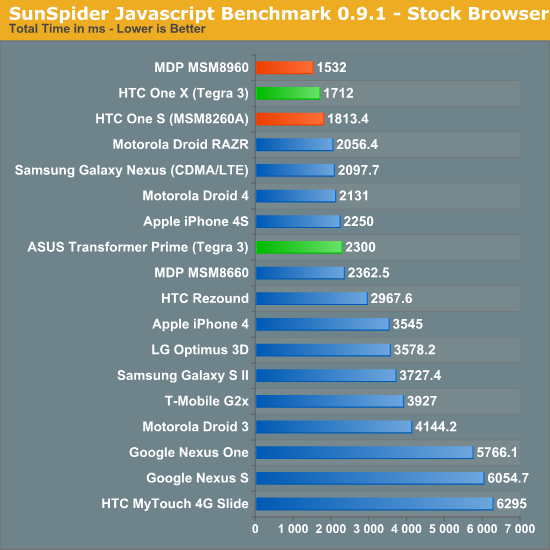
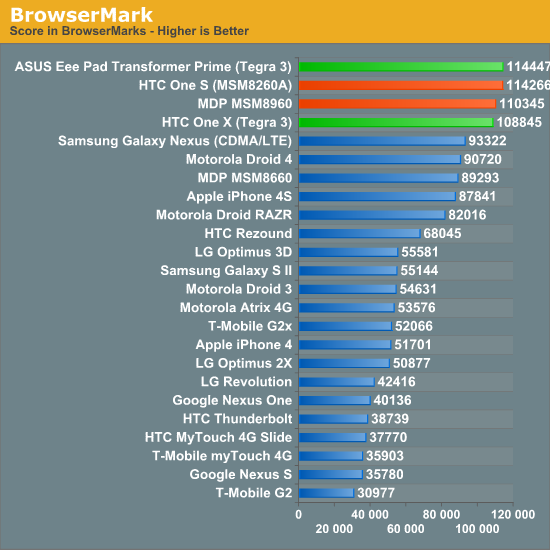
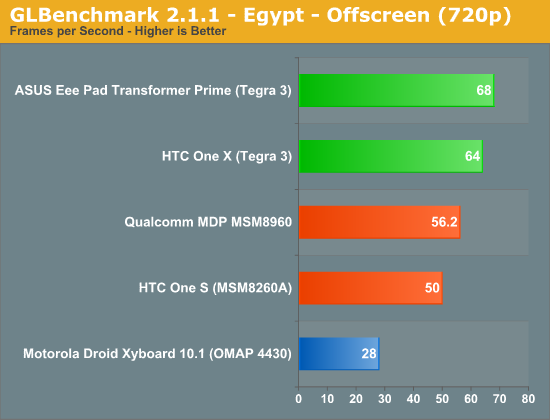
While the above results were taken using GLBenchmark's offscreen test which disables vsync and runs the benchmark at 1280 x 720, the graph below is run at each device's native screen resolution. For the HTC One X that works out to be 1280 x 720 (921K pixels) and for the HTC One S that is (518K pixels). Keep that difference in mind as the One X does have more (around 77%) pixels than the One S.
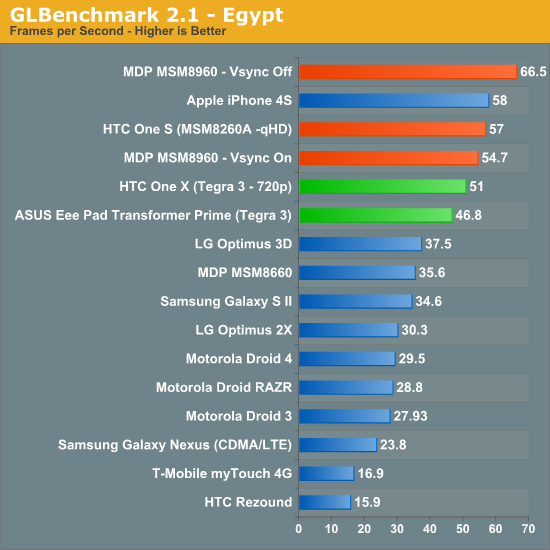

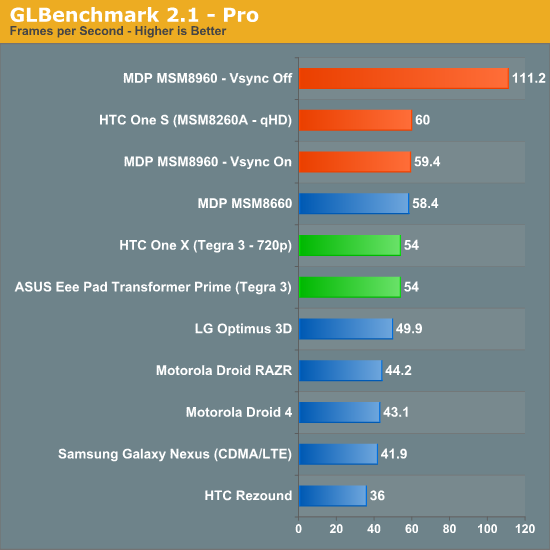
The One S (MSM8260A - dual core Krait 1.5GHz) performs surprisingly close to our MDP MSM8960 in many tests. The software build on the One S was pretty immature, it was apparently 10 days old at the time I ran these numbers. We should have time with a device tonight that uses a newer build. The Tegra 3 equipped One X performed very well, easily equaling the Krait based SoC in the browser tests. It remains to be seen how these two SoCs compare in real world browsing tests however. NVIDIA continues to have the advantage in GLBenchmark, and unfortunately due to time constraints we weren’t able to run Basemark on the devices.
HTC's strategy here makes a lot of sense for a host of reasons. First, having a concise and easy branding message makes execution and marketing simpler - just look at the success of Galaxy S II - you can't do that without a unified message. Handset makers really only get one or two opportunities in a two year contract to drive that unified message home, and HTC's new One strategy is the realization of this reality. In addition, doing this on a platform across different SoCs is no longer a huge no-no when the performance margins are narrow enough - Samsung does it, Sony is doing it, and so forth. HTC is going figuratively all-in with this strategy, but the dividends won't start to become readily apparent until HTC One devices start showing up - at this point it does seem like a solid strategy.


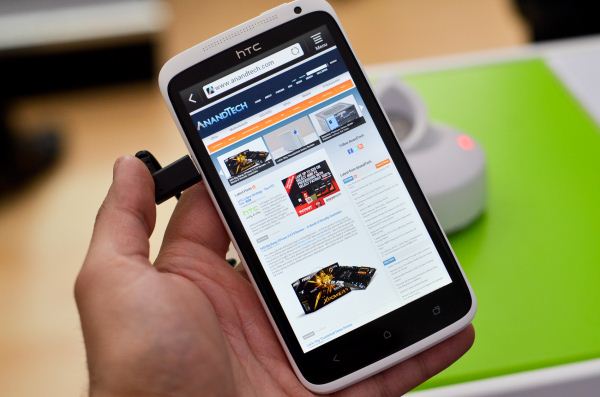
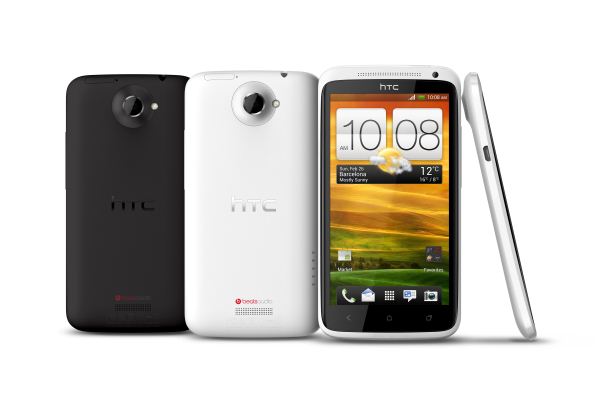






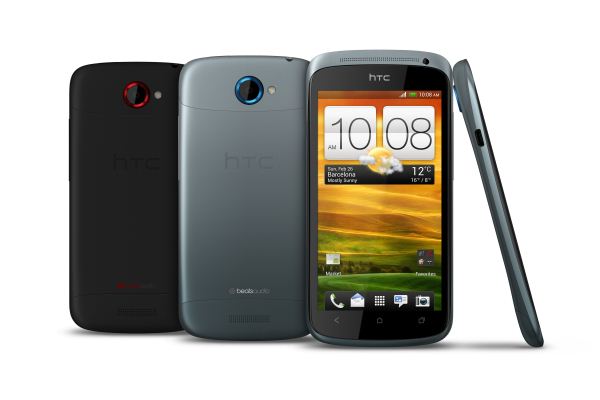






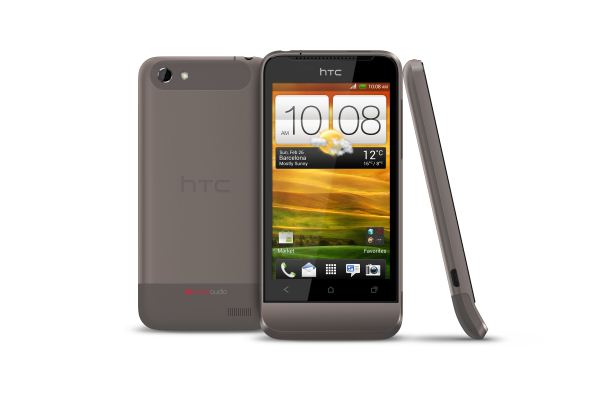








66 Comments
View All Comments
Finraziel - Friday, March 2, 2012 - link
So far, most 720p screens have been pentile, and there are quite a few people who don't want pentile. These two facts together are plenty reason to mention that this screen is NOT pentile. I don't know why you're so deadset on seeing a bias here, I think you're just reading way too much into it.ol1bit - Sunday, February 26, 2012 - link
I love my rezound, but the screen durability sucks. My droid 1 was though everything, even on my quad over 500 miles, always in my pocket.. not even a scratch.My Rezound... 2 scratches in the screen, and just in my pocket. Only 3 months old. So HTC's screen durability sucks compared with Motorola.
They better fix that!
fr33h33l - Monday, February 27, 2012 - link
So how come the HTC One X with Tegra 3 is roughly 25% faster than the Asus Transformer Prime, also with Tegra 3. The 0,2GHz difference in clock speed would only account for a 15% increase (and also, one could assume there is slighly more headroom in a tablet). Is the Prime running Honeycomb and One X ICS?Also, the GLBenchmark - Egypt shows the One X slightly slower than the Prime, despite the 0,2GHz advantage of the former. Is it because the Prime has to handle a lower resolution, which seems weird since I believe the Prime has a 1280x800 resolution (vs. 720p used in the One X in the benchmark).
Doubly confused... :-\
piroroadkill - Monday, February 27, 2012 - link
One X should be using Krait as well, Dual 1.5 is more than you'd need in a phone.Quad core in a phone is just a bloated waste of resources (who heavily multitasks that much, it's not even possible to keep multiple running windows on screen), and I'd much rather have 28nm inside than 40nm.
Then, I'd say.. What were you thinking? MicroSD is absolutely essential, and the battery is far, far, far too small.
Manufacturers need to be looking at the Droid RAZR MAXX as their benchmark. I'd still rather have a RAZR MAXX, because what use is a ridiculously huge screen and Tegra 3 when you have a flat battery? Also, RAZR manages to fit a MicroSD card.
One thing I DO like to see is a docking connector!
kyuu - Monday, February 27, 2012 - link
Totally agree. Bigger batteries and micro-SD would make these devices much more appealing.Also, I dunno if it's something T-mobile is doing or if device manufacturers just have it out for them, but they're getting the short-end of the stick big time (asides from the aluminum construction).
Lucian Armasu - Monday, February 27, 2012 - link
I wouldn't exactly call the One S close to the MDP. The difference is pretty significant. It's significant enough that it shows the MDP beats Tegra 3 in most cases, and yet One S doesn't beat Tegra 3 in most cases. And the one where it does beat Tegra 3, is where Tegra device is running on a 720p resolution, while the One S is running on a 540p resolution, and the difference is probably small enough to call it a draw.georgekn3mp - Monday, February 27, 2012 - link
I love my HTC Rezound bought on launch day 11/14/2012. Now if it only had ICS it would be like a HTC One S, not quite an One X (Krait/Tegra). One has 4.7 and Rezound has 4.3 HD 720p and that is a wonderful screen, not cartoonish colors...and Sense isnt bad, but runs faster on ICS ROMS...or Senseless ICS ROMS I have seen.So I love the Rezound but if Verizon gets a ONE X (a V model??? lol) I would probably upgrade at full retail price just for the bigger screen and ICS out of the box.
COME ON HTC...ICS will make even the Rezound a better phone, not quite "One" but not far off either. Still dual core 1.5 ghz even if it isnt Krait, and it has removable SD card, the iBeats ($100 retail)headphone included (which may or may not come with the S, bet it does with the X model...). removable battery (3175 extended FTW!) so maybe that's why ICS isnt upgraded to Rezound yet...same camera specs too.
All that sounds so much better than the Google ICS launch phone!
Finraziel - Friday, March 2, 2012 - link
Unfortunately, from what I hear, HTC no longer plans to bundle the beats headphone with their phones because it's too expensive... Doubt it translates to cheaper prices for us, so quite a shame, even if I wouldn't buy one of those headphones myself (prefer a more accurate sound to their bassheavy approach). If it does lower the retail price, then way to go, let customers choose a decent set of headphones themselves.Flyguy2929 - Thursday, March 1, 2012 - link
Finally, HTC is getting it.IPhone - 100% unmutilated. - not on ugky duckling TMobike network is the only blemish even though it procides the better 3g HSPA+ service over ATT.
Samsung Galaxy - in tact but with scarring , ""Galaxy Attain"- nasty, but Galaxy flagship-like specs on all carriers
Motorola - quarter slice of pizza - Verizon's slave with caged BRANDS like Razr and Droid (now generic) at least they are on the best network, but CDMA is killing them internationally and Moto is still losing $$$
LG- what is "optimus"? "Prada" phones reek of desperation, zero brand cache and identity
HTC?- should have resurrected "EVO" instead of "One", but ok. BUMMER- no fkagship-like specs across all carriers. HTC continues to put its BEST on one carrier, If you want "The REAL ONE", ATT is your only choice. Want an iconic brand witb top specs? Get Galaxy. Smart move is that HTC didn't put it on TMobile this time..
flyguy29 - Friday, March 2, 2012 - link
when aomeone owns Galaxy or iPhone, regardless of the carrier, consumers know it is the flagship phone of the manufaturer, even with screen and memory variances. The brand and model name says it all. Even after the galaxy has an additional carrier imoosed moniker like :-"Attain", it is still the Suoer Amoled Plus Galaxy.With the "One", you could be driving a Kia Sorento or Mercedea Benz